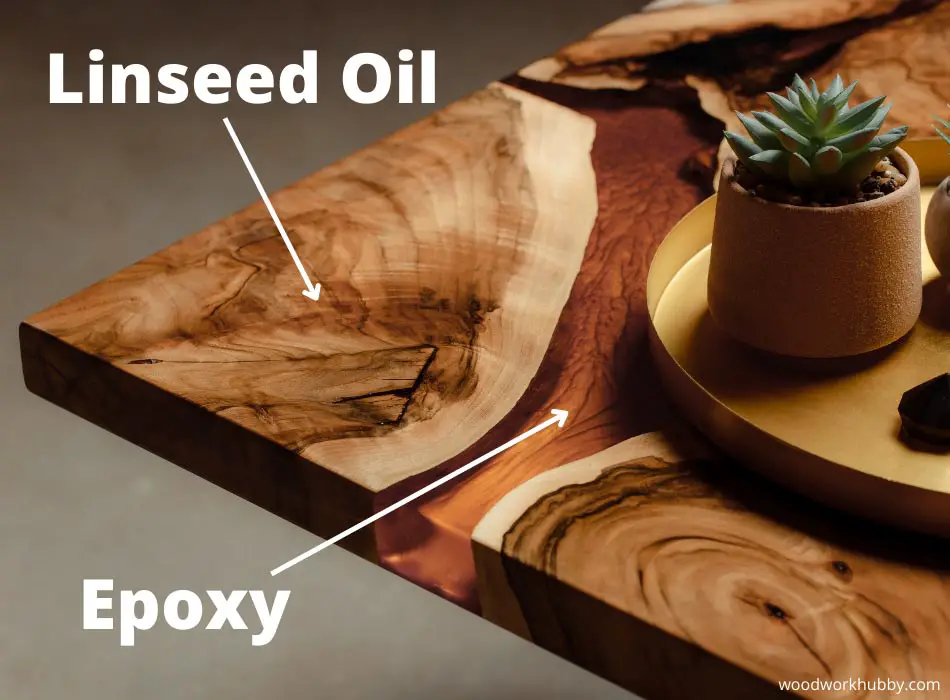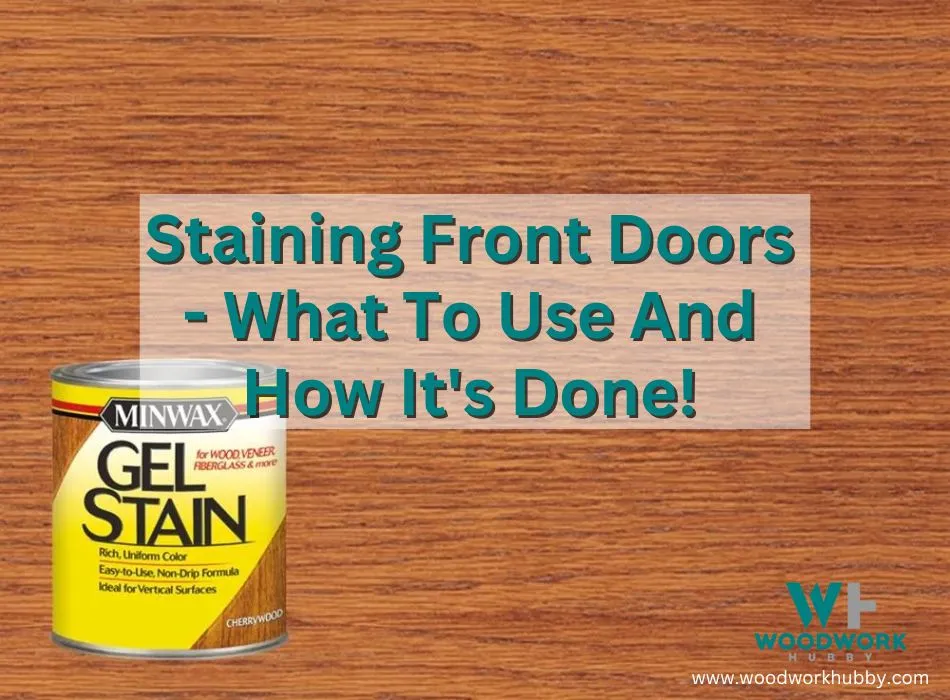Linseed oil provides a great non-toxic way of finishing wood in a semi-permanent coat that increases water resistance and durability of wood by soaking it at depth. However, the coat can wear out after a while and is by no means 100% waterproof. The first time I used linseed oil over a project, I had to go back and use epoxy to make the finish more permanent. Here’s what I found.
Epoxy can be used over linseed oil once the oil is fully dry. It works just as well as pouring epoxy over dry wood. However, it is redundant and unnecessary to apply a layer of linseed oil under epoxy when the overall project isn’t any more durable or better looking due to the oil.
Whether you have a piece of oiled wood you want to epoxy or you have yet to apply an oil finish to your project, this article will clear all misconceptions regarding the subject. By the end, you will know how to judge oiled wood to conclude if it is ready for epoxy, what happens when you pour epoxy over oiled wood and the best oil treatments for pre-epoxy wood.

Can You Epoxy Over Oiled Wood?
You can epoxy over oiled wood to a varying degree of success depending on the dryness of the oil finish. Dry finishes, once fully cured, allow the epoxy to grab onto the texture of the wood but thicker coats that create an impermeable layer between the wood and epoxy destabilize the adhesion.
Epoxy can stick to wood, and it can stick to solidified oil. However, its adhesion to oil is quite poor, which is why you must be careful using epoxy over oiled wood. First, you must inspect the extent to which the oil is noticeable.
Next, you have to look for the oil’s effect on the wood’s texture. After ensuring that the epoxy can access wood without being blocked by oil, you can proceed to epoxy over wood. The table below covers a set of possibilities.
| Appearance | Texture | Can You Epoxy Over The Surface? |
|---|---|---|
| Glossy | Smooth | No. The layer of epoxy will not bond to the underlying wood. |
| Glossy | Rough | Yes. There is a thin film of oil coating the wood, but it isn’t blocking crevasses that epoxy can fill for better anchoring. |
| Natural | Smooth | No. The oil finish might have a matte effect, but it has compromised the wood grain required. You might need to sand it before epoxying it over. |
| Natural | Rough | Yes. The dry finish used over the wood has properly oxidized, leaving wood conducive to epoxy adhesion. |
With the information covered in the table above, the following steps are the most obvious route to safely epoxying over oiled wood:
- Step 1 – Look at the surface in bright light to check if it is glossy.
- Step 2 – Gently run your finger over the surface to assess its graininess.
- Step 3 – If there is sufficient grain and little to no gloss, you can use epoxy on it.
The video below covers the results you can expect when applying epoxy over oiled wood.
Video showing results from epoxy over oiled wood
What Happens When You Epoxy Over Oiled Wood?
Pouring epoxy over oiled wood can prove disastrous for your project if you are not careful. You have to be mindful of two things: the thickness of the finish and how well it has cured.
If the oil finish has not cured properly, here are the consequences you can expect:
- The epoxy layer separates from the wood – Uncured stain or oil finish can simply form an impermeable film over which the epoxy cures. Since the epoxy doesn’t firmly anchor into the wood, it separates as a dry layer.
- There are bubbles and crates in the epoxy – When some of the oil has cured and the other parts of the finish/stain haven’t, the less dry areas repel the epoxy, creating craters where the epoxy doesn’t cure. The dry areas end up with more epoxy and sometimes have bubbles.
The best solution is to use drying oil and wait seven days after applying the oil finish or stain before you start your epoxy project. If the layer is too thick, you might even need to sand the surface.
Can You Seal Over Linseed Oil?
You can seal over linseed oil once the oil is fully dry. Waiting 96 hours (to one week) before sealing the oiled wood is the safest way to waterproof wood without destabilizing its finish. That said, you can also directly seal wood without applying linseed oil.
There is no need for oil if the sealer improves the wood’s finish and durability. Since all sealers are not built alike, one cannot say an oil finish is useless if one intends to use a sealer later on. The oil finish can introduce an interesting appearance and improve wood’s durability, while the sealer makes it waterproof.
So, there’s room for debate when using different sealers over linseed oil. But when it comes to using epoxy sealer (or any sealer that also improves wood’s durability), linseed oil is completely redundant.
Do You Oil the Wood Before Epoxy?
You don’t need to oil the wood before epoxy because the oil does not present any advantages that are missing from epoxy. From water resistance to improved durability, everything that the oil is supposed to do is done better by epoxy.
One must look at epoxying over linseed oil from the perspective of risks and advantages. The table below shows why it is not worth it to apply linseed oil on wood before sealing it.
| Advantages Of Using Epoxy To Seal The Wood (with or without linseed oil) | Disadvantages Of Using Oil And Then Epoxy Sealer |
|---|---|
| Makes the surface waterproof | Costs more because you pay for the linseed oil |
| Makes the wood scratch-resistance | There is a small chance the oil will interfere with the epoxy adhesion (if you don’t wait long enough before sealing). |
| Adds an interesting gloss to the surfaceCan turn the wood yellowish Table showing advantages and disadvantages of using epoxy over linseed oil |
In conclusion, there is no exclusive advantage to using oil before epoxying a piece of wood.
All the advantages that apply to using epoxy after applying oil are also advantages that are valid when just using wood. This is like purchasing two “all you can eat” buffet slots for a single person. You spend more money but get the advantages of one.
What Oil Do You Use for Epoxy Resin?
You don’t have to use any oil for epoxy resin but can use any dry finish oil, including but not limited to linseed oil, tung oil, and castor oil. One can also use silicone oil to create permanent cells in epoxy art. Epoxy resin is mixed with a hardener, not an oil.
Instead of looking for the perfect oil, you must get a container of Premium ACS Grade Acetone, which can be used to clean wood 15 minutes before an epoxy pour. As long as a wooden surface is clean and prepped for epoxy, you do not need to oil it.
This video shows how you can do your epoxy pour.
Video showing how to pour epoxy
Final Thoughts – Will Epoxy Stick To Linseed Oil
If you have a wood project that has been treated with linseed oil, you can wait 96 hours (or a week to be safe), then pour epoxy over it.
The oil is a dry finish variety and will not interfere with epoxy. But if the project hasn’t been treated with linseed oil and you intend to use epoxy over it, you can skip applying linseed oil altogether and simply use acetone to clean the wood.
-
Is Eucalyptus Wood Good For Outdoor Furniture? The Benefits

Choosing the right wood for your outdoor furniture can be tricky. I’ve faced the same dilemma, and after digging deep into many options, I discovered that eucalyptus wood might just have what it takes. Eucalyptus is an excellent finish for outdoor furniture. It repels water and resists rot and can help wooden outdoor furniture last…
-
Staining Front Doors – What To Use And How It’s Done!

Is your front door looking a little dull and in need of a refresh? I can relate as my own front entrance was crying out for some TLC, so I researched all about staining front doors. Combined with my 30 years of woodworking and wood finishing experience I decided to guide you through the entire…
-
Best Primer For Painting Over Stained Wood (These WORK!)

Are you struggling to paint over stained wood and having issues with optimal coverage? Believe me, I’ve been there too. After trying out various products and methods, I found the best primer for painting over stained wood! This blog post will walk you through selecting the best primer for painting over stained wood, taking into…





8 responses to “Epoxy Over Linseed Oil? Does It Work?”
[…] Some people love the smell of Linseed Oil […]
[…] simplify the process of eliminating the gooey feeling of thick linseed oil application, I have broken down the solution into easy steps that also have […]
[…] true when the veneers are supposed to be used to make cutting boards and serving trays. Most danish oils work for all exterior applications and many interior […]
[…] this post, I’ll cover different linseed oil alternatives, which is why it is essential to pinpoint the exact functions and features we are […]
[…] Epoxies work by mixing the two parts, a hardener, and a resin, together to form a putty-like substance. This substance can be applied to dry, sanded, and smooth surfaces to fill in cracks or seal the surfaces together; it’s sealing and waterproof capabilities make it ideal for furniture as well as boat building. It is considered non-toxic, but it’s always a good idea to wear gloves and have the window open when using epoxy glue. […]
[…] have found the glue to work perfectly well on linseed oil. I did try using adhesive in the first 96 hours of applying linseed oil, but when the oil was cured […]
[…] help identify which types of projects each product is suited for, the similarities between Tru Oil and Danish Oil let you know the instances where either choice works. In this section, we explore a few features and contents that are common between the two […]
[…] most cases, linseed oil goes bad because it isn’t raw or is not stored properly. This article will help you understand […]